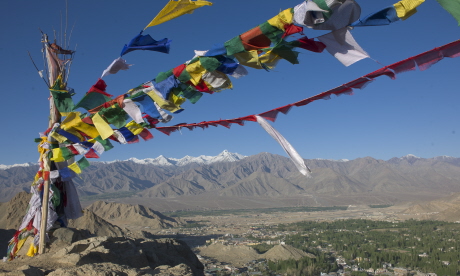
Mountains don’t move much, but that doesn’t make their majesty easy to capture. Steve Davey helps you take better peak pictures
For such solid subjects, mountains can be tricky to capture. If you opt for a wide-angle approach, trying to fit an entire range into one picture, the result is often an unsatisfying line of pimples on the horizon. Try cropping in to show one or two peaks and use a telephoto lens to fill the frame and better convey scale. A lens with a maximum setting of 200mm-300mm will do the job.
Cropping your picture vertically to show the peak’s entire pitch can emphasise its size. If you’re going to shoot a broader landscape, try to place something in the foreground: farmers ploughing terraced fields, shrines on high passes, porters carrying unfeasible loads. All will add interest.
Mountains are perfect subjects for shooting panoramas (when you take several shots in succession and strip them together to create a wide, narrow picture). Some compacts can do this in-camera. With a DSLR you’ll have to combine images on a computer – using software such as Adobe Photoshop.
The mix of snow and higher ultraviolet light levels at altitude can fool your camera meter. Snow can make the camera underexpose by up to two stops; excess UV can cause it to overexpose by up to a stop. Often these effects cancel each other, but try giving a stop more exposure for snow at altitude, a stop less at altitude without snow. Check exposure using the histogram (see the Jun/Jul 08 issue for more on this function).
Mountains can be a harsh environment. Cold diminishes battery life, so keep spares next to your body. Also be aware of condensation forming on kit. When coming into the warm, allow your camera temperature to equalise before switching it on. If you do get condensation on a lens, put it somewhere cool and dry to help it clear.
Get high: Ranges with cable car access make it much easier to achieve lofty viewpoints. Shooting into the light can give a shot a misty ethereal effect, accentuated by not correcting the UV blue cast.
Zoom in: Trying to photograph a whole mountain range can result in less than impressive pictures. Using a telephoto lens can isolate a part of a range, magnifying details. You can also use it to emphasise any symmetry. Shooting at sunrise has given this image a pleasing warm tone.
Add interest: Cropping your picture to include people in the frame can add a sense of scale and a point of interest. Placing the people at the edge of the frame and with the peaks almost reaching the top, emphasises the mountains’ size.
Foreground thought: Sometimes you’ll have to take pictures when the light is less than perfect. To minimise the effect of poor light and to create a more dynamic shot, include a large amount of foreground, placing the mountains in the background.
1. If you only remember one thing…
Don’t try to cram a whole mountain range into one picture – you won’t be able to convey the magnitude of the individual mountains. Focus on one or two peaks and consider using a vertical orientation so the mountains fill the frame.
2. Tech tip
If your camera is able, shoot using the RAW format. This will need post-processing on a computer but will allow you to tweak exposure and white balance to correct the blue cast given by excess UV. If shooting JPEGs, select the ‘Cloudy’ setting to remove this cast.
3. One for the kitbag
You should have a protective UV filter on your lens anyway, which will help minimise haze at altitude. A polarising filter has a more profound effect. Avoid really cheap ones. B+W is a great brand for pros; Hoya makes good filters for amateur/prosumer lenses.
Steve Davey shares his tips to achieve evocative and engaging portraits like the professionals | Travel photography: Taking portraits
4 classic mountain ranges and 3 lesser-known | Inspire Me... More
How to buy the right camera for you | Advice... More
Mountain travel guide | Inspire Me... More